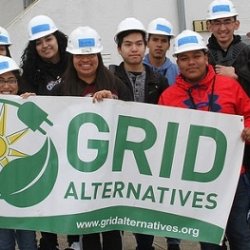Since 2015, GRID Alternatives Solar Futures program has been working to equip K-14 students with knowledge and skills within the renewable energy sector. By providing both classroom and hands-on solar education to K-14 students, with a focus on high school juniors and seniors, students gain opportunities to learn more about solar power and illuminate career pathways in the booming solar industry. The Solar Futures program leverages GRID’s hands-on solar installation model in order to educate and inspire the next generation of solar leaders, combining classroom-based sessions with real-world experience installing solar for income-qualified clients.
Here at GRID Bay Area, we have engaged hundreds of High School students, including more than 200 students this year alone through workshops, an internship program, solar presentations and installations! One of the key players of this banner year is Marissa Leshnov, the SolarCorps Workforce and Volunteer Fellow. As she reaches the end of her SolarCorps year of service, we interviewed her to learn about the programmatic work she’s been involved in over her term:
Q. How have you been involved in GRID Bay Area’s Solar Future work?
I’ve facilitated several Solar Futures High School programs, serving as a content curator, in-classroom presenter, on-site trainer and more. We’ve partnered with local high schools and organizations serving high school students to create and implement programming to introduce solar to students. It’s been great being a thought leader in what the mission and vision of Solar Futures is in the Bay Area.
Q. Why do you think it is it important to include students in the transition to clean renewable energy?
Younger generations need to know about solutions to climate change, since it’s an issue that is already affecting these generations and will only continue to do so. To create a better future, young people need to be excited, knowledgeable and hopeful about solutions and we want to empower them to be a part of that. It’s about inspiring and mobilizing future movers and shakers!
Q. What types of students are included in Solar Futures training?
It’s important to work with students from all backgrounds. It’s valuable to be informed about the barriers that are in place to an equitable and inclusive clean energy transition. But it’s not just about educating students who have been negatively impacted by the systems disproportionately. It’s important that people who have benefited from societal privilege know about these systems of oppression too. Knowing leads to action, and you can’t solve a problem if you don’t know that it exists. The Solar Futures program provides young people with the tools and platform to learn about these issues and take action. A successful clean energy transition needs to be an all-hands-on-deck effort.

Q. What has been a highlight?
After our team noticed the need for deeper engagement and relevance to the students, I began creating materials and activities that would have a stronger impact with the students. Much of the curriculum was “gamified” and made even more hands-on. When we brought it to the classroom, the students really connected with it. One of the facilitators remarked that one of the students had never been so engaged and happy. This new curriculum clicked with the students, and it was just fun. For me, this work has been about innovating ways to engage with students beyond powerpoints: not just telling, but putting the tools in their hands. This is about making students excited to get up in the morning and to carry that excitement with them as they look at their futures - there’s a reason the program has its name!
A huge thank you to all of the students and schools we work with and to Marissa and GRID Bay Area’s whole Workforce Development team who have made this a banner year for educating students and planting the seeds of a brighter future for everyone!

